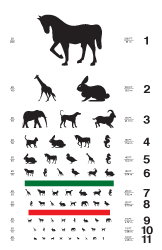The human eye captures images from the outside world and projects it as electrical impulses to the brain. The function of our eye, is therefore, to see. However we do not, all, see equally due to various reasons. The question is how much do we see and how do we measure it?
The clearness of vision is called Visual Acuity. It is dependent on a variety of factors within and outside the eye. Some of them are as follows:
- The ability of the lens system of the eye to focus on the retina
- Obstacles in the path of the light rays from the image
- Health of the retina
- Health of the visual cortex of the brain
- Ambient light
- Distance and size of object viewed
- General health of the patient
- Mental ability of the patient to understand the test
Measurement of visual acuity is usually done using what is called the Snellen’s chart. This chart has letters or characters that can be identified by the person being examined printed on them. It can have alphabets, numbers, objects or pictures. A standard chart has not less than 7 lines and the letters or characters in each line has a certain size which can be viewed by a person from a particular distance; usually 6 meters.
In the metric system of measuring visual acuity it is recorded as a fraction with the number 6 as the numerator. Eg: 6/6, 6/18, 6/60 etc. The numerator (6) is the distance in meters between the the subject and the chart. The denominator is the (Eg: the 18 in 6/18) is the number representing what the subject can read, which a normal person reads at 18 meters.
So if the visual acuity of an eye is mentioned as 6/60 it means that the tested eye can see an object which a normal eye would see even at 60 meters. You can then work out each line of the chart that way. The 7th line is the line representing the ‘normal’ 6/6 visual acuity.
Some charts have one or two lines more than the 7th line representing objects so small that they can be viewed clearly on if the subject stands closer than 6 meters, (6/5 and 6/4).
When it comes to children, measuring visual acuity can be a problem. Especially in preschoolers. In that case, charts with pictures can be used.
Even then, you should remember that children being afraid of doctors in general, will not be as cooperative as adults. Therefore if they fail to read all the lines it should not be treated as a case for spectacles unless a detailed refraction is done.
Is it absolutely necessary to have 6/6 vision? Not really. In India a person is said to be legally blind if the better eye has less that 6/60 vision. Any person who has vision between 6/6 -6/18 in the better eye is classified as normal.
Click this link to know more about Visual Impairment and it’s classification
It is not the 6/6 that matters, it is how useful the visual acuity is functionally. A person with poor vision can go about his normal activity without any problem. Therefore if your daily routine activity is not compromised by your visual acuity (that maybe less than ‘normal’) you needn’t be bothered about not having a 6/6 vision.
To put it simply. Every person is different. The average Indian male is around 165-170 cms. Do all the dwarfs try to grow up to that height or do taller men try to grow short to be ‘average’?
If your eye can’t see 6/6 but you are able to go about your work normally, don’t be upset that you can’t see as well as your friend or neighbour. It is perfectly normal to have eyesight that is a little below or above normal. If you are obsessed by the number 6/6 you can rest assured that you will either end up wearing an unnecessary spectacle or spend a fortune on expensive supplements which will not help achieve your aim!!

